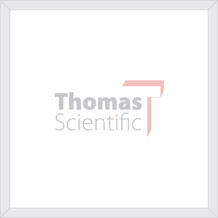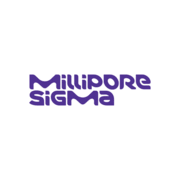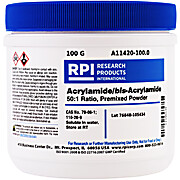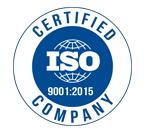Acrylamide Bisacrylamide Solution
Our Acryl/Bis Solutions are formulated with precise ratios, such as the commonly used 30% acrylamide bis solution, delivering optimal polymerization and gel strength. This consistency is crucial for achieving reliable electrophoresis results, particularly in protein and DNA analysis.
Available in different concentrations and volumes, these acrylamide bisacrylamide solutions cater to various experimental needs, from small-scale research to larger laboratory applications. These solutions are compatible with most electrophoresis equipment and protocols, offering versatility and convenience.
For researchers looking for reliable, high-quality acrylamide solutions, our Acryl/Bis Solutions provide the accuracy and ease necessary for successful gel electrophoresis.
-
Acrylamide/bis-Acrylamide, 29:1
RPI (Research Products International)A 40% solution containing 38.67% (w/v) Acrylamide and 1.33% (w/v) bis-Acrylamide for a monomer to crosslinker ratio of 29:1.
-
2% Bisacrylamide Solution
Bio Basic Inc.The Bio Basic Inc. 2% bisacrylamide solution is suitable for research and laboratory use. It is mainly used in electrophoresis applications.
-
Acrylamide/bis-Acrylamide, 19:1 Solution
RPI (Research Products International)A 40% solution containing 38% (w/v) Acrylamide and 2% (w/v) bis-Acrylamide for a monomer to crosslinker ratio of 19:1.
-
Acrylamide/Bisacrylamide; Premixed Powder 37.5:1
G-BiosciencesFeatures Premixed acrylamide and bisacrylamide at a ratio of 37.5:1 Acrylamide CAS #: 79-06-1 Acrylamide synonym: 2-Propenamide Acrylamide chemical formula: C3H5NO Acrylamide molecular weight: 71.08 Bisacrylamide CAS #: …
-
N,N’-Methylenebisacrylamide, 97%
BeanTown ChemicalCAS: 110-26-9 EC No: 203-750-9 MDL No: MFCD00008625 RTECS: AS3678000 Solid Molecular Formula: C7H10N2O2 MW: 154.17 Melting Point: >300° Density (g/mL): 1.235
-
Acrylamide/bis-Acrylamide, 19:1
RPI (Research Products International)Pre-measured powder blend of acrylamide and bis-acrylamide for simple stock solution preparation.
-
Carbenicillin, Disodium Salt
IBI ScientificCarbenicillin is an antibiotic which inhibits bacterial cell wall synthesis, activity against gram-positive and gram-negative bacteria, and for cell culture media applications. Recommended use is 100mg/ml. Stock solution of antibiotics dissolved in water should be sterilized by filtration…
-
Acrylamide Solution, 40%
G-BiosciencesFeatures Synonym: 2-Propenamide CAS Number: 79-06-1 Linear Formula: C3H5NO Molecular Weight: 71.08
-
Acryl/Bis Solution, 40% (w/v)
Bio Basic Inc.Acryl/Bis solution (19: 1), 40% (w/v): SDS-PAGE (Sodium Dodecyl Sulfate PolyAcrylamide Gel Electrophoresis) is commonly used electrophoretic techniques for separating proteins. There are two major PAGE method, Glycine-SDS-PAGE1 (also known as Laemmli-SDS-PAGE) and Tricine-SDS-PAGE2, based on…
-
RPI Acrylamide
RPI (Research Products International)The RPI acrylamide with strong concentration levels should always be stored in a room temperature and is used in research and manufacturing applications. Application: For Research or Further Manufacturing use only
-
Bis (N,N'-methylenebisacrylamide) solution, 2%
G-BiosciencesFeatures Synonym: Bisacrylamide CAS #: 110-26-9 Chemical formula: C7H10N2O2 Molecular weight: 154.17
-
Ammonium Persulfate
IBI ScientificA potent oxidizer that promotes polymerization of acrylamide gels by scavenging dissolved oxygen in the gel solution, thereby accelerating the acrylamide/ bisacrylamide reaction. Store at room temperature. Protect from moisture. Oxidizer. Contact with other materials may cause fire or…
-
Acrylamide For Synthesis
MilliporeSigmaSynonyms: Acrylamide; Prop-2-enamide Molecular Formula: C3H5NO Molecular Weight: 71.08 Linear Structural Formula: C3H5NO MDL Number: MFCD00008032 Purity: >=99% (GC) Melting Point: 84 C Density: 1.127 g/cm3 at 25 C
-
Acryl/Bis Solution, 30% (w/v)
Bio Basic Inc.Acryl/Bis solution (19: 1), 30% (w/v): SDS-PAGE (Sodium Dodecyl Sulfate PolyAcrylamide Gel Electrophoresis) is commonly used electrophoretic techniques for separating proteins. There are two major PAGE method, Glycine-SDS-PAGE1 (also know as Laemmli-SDS-PAGE) and Tricine-SDS-PAGE2 , based on…
-
Acrylamide/bis-Acrylamide, 37.5:1
RPI (Research Products International)A 40% solution containing 38.96% (w/v) Acrylamide and 1.04% (w/v) bis-Acrylamide for a monomer to crosslinker ratio of 37.5:1.
-
Acryl/Bis Solution, Premix Powder
Bio Basic Inc.Acryl/Bis solution (19: 1) Premix powder: SDS-PAGE (Sodium Dodecyl Sulfate PolyAcrylamide Gel Electrophoresis) is commonly used electrophoretic techniques for separating proteins. There are two major PAGE method, Glycine-SDS-PAGE1 (also know as Laemmli-SDS-PAGE) and Tricine-SDS-PAGE2, based on…
-
N,N'-Methylenebisacrylamide, 99%
BeanTown ChemicalCAS: 110-26-9 EC No: 203-750-9 MDL No: MFCD00008625 RTECS: AS3678000 Powder Molecular Formula: C7H10N2O2 MW: 154.17 Melting Point: >300° Density (g/mL): 1.235
-
Acrylamide and bis-acrylamide are major ingredients in polyacrylamide gels, a commonly used matrix for electrophoretic separation of nucleic acids and proteins. Fragments of DNA produced by various molecular biology techniques (eg. restriction endonuclease digestion, dideoxy sequencing, or the…
-
Acrylamide/bis-Acrylamide, 37.5:1
RPI (Research Products International)Pre-measured powder blend of acrylamide and bis-acrylamide for simple stock solution preparation.
-
Acrylamide/bis-Acrylamide, 50:1 Ratio
RPI (Research Products International)Acrylamide/bis-Acrylamide, 50:1 Ratio
-
Bis-Acrylamide
Bio Basic Inc.The Bio Basic Bis-Acrylamide with a composition of Application: For Laboratory Research Use Only
-
Acrylamide, 98%
BeanTown ChemicalCAS: 79-06-1 EC No: 201-173-7 MDL No: MFCD00008032 RTECS: AS3325000 UN No: UN2074; Haz Class: 6.1; Packing Group: III Crystalline Linear Formula: CH2=CHCONH2 MW: 71.08 Melting Point: 82-86° Boiling Point: 125°/25 mmHg Flash Point:…
-
-
TEMED
Bio Basic Inc.TEMED (TMEDA, 1, 2-Bis(dimethylamino)ethane): TEMED (TMEDA, 1, 2-Bis(dimethylamino)ethane)
-
Acrylamide
Bio Basic Inc.The Bio Basic Acrylamide with a composition of Application: For Laboratory Research Use Only
-
Bis (N,N'-methylenebisacrylamide)
G-BiosciencesFeatures Synonym: Bisacrylamide CAS #: 110-26-9 Chemical Formula: C7H10N2O2 Molecular Weight: 154.17
-
-
Acrylamide
MP BiomedicalsAcrylamide is prepared on an industrial scale by the hydrolysis of acrylonitrile by nitrile hydratase. Acrylamide is a monomer used in a variety of synthetic processes to form polymers and copolymers. It polymerizes in the presence of free radicals in aqueous solutions. It is usually used to…
-
Acrylamide/ Bisacrylamide (37.5:1); 40% Solution
G-BiosciencesFeatures 40% Solution, 38.96% solution containing acrylamide (40%) and bisacrylamide (1.04%) for cross-linker ratio of 37.5:1 Acrylamide CAS #: 79-06-1 Acrylamide synonym: 2-Propenamide Acrylamide chemical formula: C3H5NO Acrylamide molecular weight: …
-
Acrylamide, 99%
BeanTown ChemicalCAS: 79-06-1 EC No: 201-173-7 MDL No: MFCD00008032 RTECS: AS3325000 UN No: UN2074; Haz Class: 6.1; Packing Group: III Crystalline Linear Formula: CH2=CHCONH2 MW: 71.08 Melting Point: 82-86° Boiling Point: 125°/25 mmHg Flash Point:…
-
Acrylamide/bis-Acrylamide, 29:1
RPI (Research Products International)Pre-measured powder blend of acrylamide and bis-acrylamide for simple stock solution preparation.
-
N,N-Dimethylacrylamide, 99.5%, stabilized
BeanTown ChemicalCAS: 2680-03-7 EC No: 220-237-5 MDL No: MFCD00008626 RTECS: AU3230000 UN No: UN2810; Haz Class: 6.1; Packing Group: III Liquid Molecular Formula: C5H9NO MW: 99.13 Melting Point: -40° Boiling Point: 80-81°/20 mmHg Flash Point: 70°C…
































